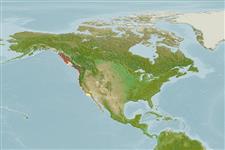>
Perciformes/Cottoidei (Sculpins) >
Cottidae (Sculpins)
Etymology: Artedius: Petrus (Peter) Artedi, (10 Mar.) 1705-35 (28 Sep.), a son of a clergyman from Anundsjö named Olaus Arctaedius, in the northern part of Sweden.In 1729 he changed his name from Arctaedius to Arctædi, a name still later simplified to Artedi (Ref. 45335); harringtoni: Named for Mark W. Harrington, President of the University of Washington (Ref. 6885).
More on author: Starks.
Environment: milieu / climate zone / depth range / distribution range
นิเวศวิทยา
เกี่ยวกับทะเล,น้ำเค็ม สัตว์น้ำหน้าดิน; ระดับความลึก 1 - 21 m (Ref. 2850). Temperate; 58°N - 32°N, 155°W - 118°W
Eastern Pacific: Kodiak Island, Alaska to San Miguel Island, southern California, USA.
ขนาด / น้ำหนัก / Age
Maturity: Lm ? range ? - ? cm
Max length : 10.0 cm TL เพศผู้/กระเทย; (Ref. 2850)
เงี่ยงครีบหลัง (รวม): 9 - 10; ก้านครีบอ่อนที่หาง (รวม): 16-18; เงี่ยงครีบก้น 0; ก้านครีบอ่อนที่ก้น: 10 - 14. Pelvic fins small.
Found in intertidal and subtidal rocky areas, around pilings (Ref. 2850). Males are territorial (Ref. 6885). Sexual dimorphism is remarkable (Ref. 74407). Males guard eggs (Ref. 74407).
Life cycle and mating behavior
วัยเจริญพันธุ์ | การสืบพันธุ์ | การวางไข่ | เซลสืบพันธ์ของเพศเมีย(ไข่) | ความดกของไข่ | ตัวอ่อน
Males guard clutches of eggs and are quite territorial (Ref. 74407). The following account of mating behaviour comes from Ragland et.al. (1978): observed from an aquarium, courtship began 'when a gravid female approached a shelter occupied by a male. The male, which was not guarding eggs, responded by rolling its head in a circle and flaring the orange branchiostegal membranes. The cirri were not moved or deployed in any obvious fashion.
The female either ignored the male or responded by snapping the head horizontally several times in rapid succession and occasionally quivering. Once she entered the nest, the male often extruded its pene and performed bouts of a fanning display similar to those of other cottids (Ref. 205). The female left the nest shortly after laying eggs.'
Occurrence of intromission was not observed from this study due to technical problems. However, eggs stripped from gravid females developed and hatched after 11-15 days in the absence of a male, thereby supporting the hypothesis that internal fertilization had occurred.
Eschmeyer, W.N., E.S. Herald and H. Hammann, 1983. A field guide to Pacific coast fishes of North America. Boston (MA, USA): Houghton Mifflin Company. xii+336 p. (Ref. 2850)
IUCN Red List Status (Ref. 130435)
Threat to humans
Harmless
Human uses
สถานที่แสดงสัตว์และพืชน้ำ: สถานแสดงสัตว์น้ำของรัฐ
ข้อมูลเพิ่มเติม
ชื่อสามัญชื่อพ้องกลไกการเผาผลาญพลังงานผู้ล่าการศึกษาเกี่ยวกับผลกระทบของสารประกอบทางเคมีที่เป็นอันตรายต่อสิ่งมีชีวิต ประชากร และสิ่งแวดล้อมการสืบพันธุ์วัยเจริญพันธุ์การวางไข่การรวมกลุ่มวางไข่ความดกของไข่เซลสืบพันธ์ของเพศเมีย(ไข่)Egg development
อ้างอิงการเพาะเลี้ยงสัตว์น้ำประวัติการเพาะเลี้ยงสัตว์น้ำสายพันธุ์พันธุศาสตร์ElectrophoresesอัตราพันธุกรรมโรคการแปรรูปNutrientsMass conversion
ผู้ร่วมมือรูปภาพหลายรูปStamps, Coins Misc.เสียงปลามีพิษ เช่น ปลาปักเป้าความเร็วรูปแบบการว่ายน้ำพื้นที่เหงือกOtolithsสมองวิสัยทัศน์
เครื่องมือ
Special reports
Download XML
แหล่งที่มาจากอินเตอร์เน็ต
Estimates based on models
Preferred temperature (Ref.
123201): 7.1 - 12.8, mean 10.1 °C (based on 178 cells).
Phylogenetic diversity index (Ref.
82804): PD
50 = 0.5312 [Uniqueness, from 0.5 = low to 2.0 = high].
Bayesian length-weight: a=0.00676 (0.00300 - 0.01523), b=3.17 (2.98 - 3.36), in cm total length, based on LWR estimates for this (Sub)family-body shape (Ref.
93245).
ระดับชั้นอาหาร (Ref.
69278): 3.4 ±0.52 se; based on food items.
ความสามารถในการกลับคืนสู่ปกติ (Ref.
120179): ขนาดกลาง, เวลาต่ำสุดที่จะทำให้ประชากรเพิ่มขึ้นเป็น 2 เท่าใช้เวลา 1.4 - 4.4 ปี (Preliminary K or Fecundity.).
Fishing Vulnerability (Ref.
59153): Low vulnerability (10 of 100).
Nutrients (Ref.
124155): Calcium = 142 [51, 339] mg/100g; Iron = 0.46 [0.21, 1.08] mg/100g; Protein = 17.3 [15.0, 19.5] %; Omega3 = 0.602 [0.229, 1.706] g/100g; Selenium = 7.75 [3.04, 20.40] μg/100g; VitaminA = 35.5 [9.1, 131.4] μg/100g; Zinc = 0.973 [0.600, 1.752] mg/100g (wet weight);
